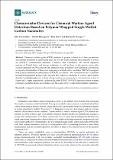Chemiresistor Devices for Chemical Warfare Agent Detection Based on Polymer Wrapped Single-Walled Carbon Nanotubes
Author(s)
Hamaguchi, Hitoshi; Fennell, John Francis; Yoon, Bora; Swager, Timothy M
Downloadsensors-17-00982.pdf (2.594Mb)
PUBLISHER_CC
Publisher with Creative Commons License
Creative Commons Attribution
Terms of use
Metadata
Show full item recordAbstract
Chemical warfare agents (CWA) continue to present a threat to civilian populations and military personnel in operational areas all over the world. Reliable measurements of CWAs are critical to contamination detection, avoidance, and remediation. The current deployed systems in United States and foreign militaries, as well as those in the private sector offer accurate detection of CWAs, but are still limited by size, portability and fabrication cost. Herein, we report a chemiresistive CWA sensor using single-walled carbon nanotubes (SWCNTs) wrapped with poly(3,4-ethylenedioxythiophene) (PEDOT) derivatives. We demonstrate that a pendant hexafluoroisopropanol group on the polymer that enhances sensitivity to a nerve agent mimic, dimethyl methylphosphonate, in both nitrogen and air environments to concentrations as low as 5 ppm and 11 ppm, respectively. Additionally, these PEDOT/SWCNT derivative sensor systems experience negligible device performance over the course of two weeks under ambient conditions. Keywords: conjugated polymers; chemical warfare agents; carbon nanotubes; chemiresistors; sensors
Date issued
2017-04Department
Massachusetts Institute of Technology. Department of ChemistryJournal
Sensors
Publisher
MDPI AG
Citation
Fennell, John et al. “Chemiresistor Devices for Chemical Warfare Agent Detection Based on Polymer Wrapped Single-Walled Carbon Nanotubes.” Sensors 17, 5 (April 2017): 982 © 2017 The Author(s)
Version: Final published version
ISSN
1424-8220